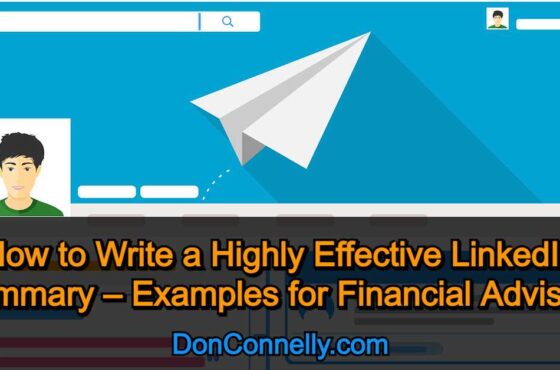5 Grave Mistakes Financial Advisors Make on LinkedIn
 You already know how dangerous for your business not using LinkedIn could be, don’t you? With more than 5 million affluent investors on the network, Financial Advisors cannot afford to overlook using it as a networking and prospecting tool.
You already know how dangerous for your business not using LinkedIn could be, don’t you? With more than 5 million affluent investors on the network, Financial Advisors cannot afford to overlook using it as a networking and prospecting tool.
But like with any aspect of your marketing, there are best practices for making the most of LinkedIn, as well as common mistakes to avoid. .
Here are 5 mistakes Financial Advisors make on LinkedIn.
Let’s start with a couple of small and seemingly insignificant details which can have a great negative impact, and end the list with a few strategic errors which could seriously hinder your prospecting efforts.
1. Not using a professional LinkedIn photo
You name it, I have seen it. It is peculiar how Financial Professionals conduct their business very responsibly and in the same time, place ridiculous LinkedIn profile photos.
Why on earth would you think a photo in a restaurant setting with a flushed face and a glass of whiskey in hand will aid your business? You probably thought it’s a good idea to project the success image (you know – whiskey, celebration, big account, many assets under management) but the association is more with a person who likes social outings, having fun and drinking till dawn rather than managing money successfully.
The other day I saw an Advisor whose profile photo was of her and her cat. Sure, we all like cat videos on YouTube, but that’s for our free time. No investor will trust you with their money because of your pet cuteness.
Ideally, you should have a professionally taken photo to use across all online profiles – website and blog page, LinkedIn profile, industry associations, etc. Alternatively, you can use a photo from a professional setting – in your office, during a meeting or industry event, anything that shows you in action, so to speak – communicating with clients and helping them achieve their financial goals.
And remember – your profile photo should not be a company logo, an avatar or a group picture. I know it’s tempting to show off that you met a famous Hollywood actor that one time, but unless your whole profile is geared toward acquiring Hollywood actors as clients, such a profile photo won’t do you any favors. Nobody will trust you with their money because of your acquaintance with a movie star.
2. Not writing a specific value-focused by-line with your ideal client in mind
Along with your profile photo, potential LI connections and prospective clients see your by-line first. You have only a few seconds to capture their attention.
Which do you think will have more impact?
“Retirement Plan Consultant at [Name of your company goes here]”
Or
“Helping you grow your money and achieve the retirement comfort you deserve”
The first one is very specific and will help you reach those prospects who know exactly what they are looking for. However, over 3500 retirement plan consultants showed up when I searched for one on LinkedIn. Whom do I contact if they are all “retirement plan consultants”?
That’s right, as an investor, I’ll contact the advisor with the second type of by-line. And do you know why?
Because it suggests that I, the investor, and my interest in growing my money and achieving a comfortable retirement, is what the Advisor has as their primary objective.
Therefore, be sure to write a specific by-line so that you capture narrow searches on LinkedIn but also, a value-focused by-line so that you engage your ideal clients and convince them to click through and see your profile in details.
3. Not writing a value-focused profile summary
The third grave mistake most Financial Advisors make on LinkedIn is talking too much about themselves in the profile summary, or leaving it empty altogether.
Listing your job history will not convince potential clients of your skills. Investors can turn to too many advisors for advice. Therefore, you should differentiate yourself.
By not writing a compelling profile summary you will not stand apart from the crowd. Highlighting the value you bring to the table will.
Instead of talking too much about yourself or your company, focus on what’s in it for your client. What are the benefits they will have if they get in touch with you? How will working with you improve their life?
When looking at your LinkedIn profile, prospects rarely, if ever care how many offices you have across the country, what certifications you hold, or what services you offer. They are looking for someone whom they trust and like. They need a partner who will listen to them and have their best interest in mind when leading the way to their financial goals.
While you need to confirm with your firm’s Compliance Department what you can and cannot put in your LinkedIn profile summary, one thing is for sure: Prospects will want to do business with you because of who you are, not because of the hard data you can give them about your firm or services.
Therefore, be sure to highlight the value you offer but also, to come across as likeable and trustworthy in your profile on LinkedIn.
4. Not taking the time to connect with others
While choosing a suitable profile photo and crafting a good by-line or summary might be considered a detail, how you handle connection requests and the communication that follows can make or break your success on LinkedIn on a strategic level.
You are a very busy professional, I get that. You are used to talking on the phone. Speaking in real time is easy.
But why do you think it’s a good idea to give your phone number to newly acquired connections and demand a call to “further discuss”?
They may or may not be interested in further discussing anything with you, let alone your service offering. Assuming otherwise will often put off your prospect. After all, when reaching out through LinkedIn, they chose not to call you.
Often, prospects are busy, just like you are. They prefer to gather information online. They are probably in touch with several Advisors and they simply cannot squeeze in their calendar a call with each and every one of them. Therefore, they exchange a few messages with connections to determine who is a potentially good match in terms of communication skills and mindset.
Respect their decision. Don’t try to immediately move the conversation away from LinkedIn as you risk losing them for good.
Instead, take the time to learn more about your new connection. Are they a prospective client? Can you help? How can you help? What is the problem that they have? Can you resolve it? What is the solution they are looking for? What is it that they want to hear in order to take the next step to hiring your service? Will a phone call help?
Get to know the connection and drive the conversation in the desired direction so that they request your phone number to further discuss. Only then, your phone call would be a success. Otherwise, if you try to get them on the phone or sell something the minute you connect, you risk never hearing from them again. Not for some other reason but because you force your work model on your prospect without giving them a chance to get to know you and to decide if they truly want to even discuss doing business with you.
Don’t forget that prospects who reach out to you through LinkedIn might have a different approach from your approach to communication and gathering information. Go along with it. Follow their lead and guide the conversation in the direction both of you would benefit from.
5. Not integrating LinkedIn with other communication channels in your business
And finally, the last but not least strategic error I see Financial Advisors make on LinkedIn is using the network as an isolated tool.
Chances are you use email to market your business and to stay in touch with clients and prospects. You probably use social media channels, too. And you might as well have a blog, do you?
Make sure you integrate your LinkedIn activities with everything else you do online. Your profile should not be a static representation page that you have online. It should change and grow as you do. It should be a go-to place for prospects and clients to keep an eye on you and stay updated on what’s new with you and your firm.
Include a link to your LinkedIn profile in your email signature. Add a profile widget on your blog to help your readers connect with you on LinkedIn with a couple of clicks. Invite your list contacts to connect. This is yet another way to proactively grow your network of connection by tapping the pool of contacts you already have on other channels.
Broadcasting a strong message across all communication channels consistently can do wonders for your brand and name recognition. Make sure your LinkedIn profile is an integral part of that.
The importance of LinkedIn for Financial Advisors is growing.
With the ever changing online environment, the role of social media is growing in importance. In no way will it replace the value of personal networking but it sure is a great way to prospect new clients and to keep in touch with your existing client base. Avoid these five mistakes and you will be one step ahead of your competition on LinkedIn.
Above all, develop your soft skills to become an Elite Advisor.
Become an Elite Advisor with Don Connelly 24/7
Click to watch a video how Don can help you open more accounts and build rapport with clients.




As always, great article!
Thanks for your positive feedback, Ronnie! Happy networking 🙂
~Diana
You made my night for tomorrow
I’m glad the post proved helpful to you, Fritz – let me know if you need help honing your networking skills 🙂 ~Diana
Very good, thanks for sharing
You’re welcome, David – happy networking & prospecting 🙂 ~Diana